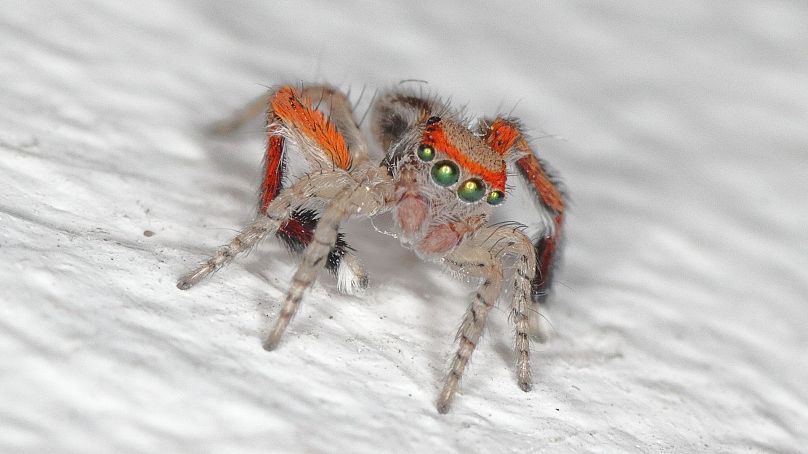"It's a bit of a head-scratcher what's going on here."
Jumping spiders are a flamboyant species, with names inspired by peacocks and red cardinal birds. But a new study shows they can’t appreciate their vivid looks - as they are in fact colourblind.
Saitis barbipes is a common jumping spider found in Europe and North Africa - males have a furry red crown and legs. Their colour is thought to complement their elaborate courtship dances when wooing females.
But an international team at the University of Cincinnati, US, has discovered that their bright colours are not what they use to attract each other because the truth is they can’t see it.
"We assumed they were using colour for communication. But we didn't know if their visual system even allowed them to see those colours," said David Outomuro, a UC postdoctoral researcher now at the University of Pittsburgh.
Biologists collected spiders in Slovenia for a lab study in Germany and used a process called ‘microspectrophotometry’ to identify photoreceptors in the spiders’ cells that are sensitive to various light wavelengths or colours. It was published in the journal The Science of Nature.
Unexpectedly, they found no evidence of a red photoreceptor - meaning the spiders can’t tell that they are red. They also looked for colour filters within the eye that might shift green sensitivity to red, but found none.
So the red colours that are so vivid to us likely appear as mere black markings to jumping spiders.
"It's a bit of a head-scratcher what's going on here," says professor Nathan Morehouse.
So why are the spiders so brightly coloured if it’s not for mating purposes?
Animals use colour in all sorts of ways, including camouflage, warning potential predators of their toxicity, showing off to potential mates or intimidating rivals.
Some even glow in the dark.
But it's not always apparent what bright colours might signify.
“We spent a lot of time talking about it as a group. What else could it be? I feel there's an interesting story behind the mystery.”
Males have bold red and black colours on their forward-facing bodies, whereas females lack red colouration altogether, according to co-author Cynthia Tedore at the University of Hamburg. "This initially suggested to us that the red colour must play some role in mate attraction.”
"Instead, we found that red and black are perceived equivalently, or nearly so, by these spiders and that if red is perceived as different from black, it is perceived as a dark 'spider green' rather than red," Tedore goes on.
So the findings suggest that the spider's red and black colours might actually be there in order to improve defensive camouflage.
"For predators with red vision, at natural viewing distances, the spider's red and black colour patches should blur together to become an intermediate orangish-brownish colour, which would help the spider blend in with its leaf litter habitat better than all-black coloration would," explains Tedore.
This discovery, according to Morehouse, is a reminder of how animals can perceive the world in very different ways to us. For example, sun cream absorbs ultraviolet light extremely well, but we never notice because we can't see that spectrum.
"If aliens were to study us, they might ask, 'Why did they paint their bodies with strongly UV absorbing colours when they went on the beach?' We have no perception of ultraviolet light, so we have no idea we're creating these strong ultraviolet colours when we put sunscreen on," he says.
“It's inherently fascinating to imagine our ways into the lives of animals that experience the world in a way that is completely alien to us.”













